
History of Lili Ledy
Lili Ledy was Mexico's premiere toy manufacturer but because of trade law restrictions, all toys they sold had to be manufactured
in Mexico. Thus, many popular US toy lines were licensed and produced by Lili Ledy in Mexico resulting in wonderful variations
that toy collectors search for to this day. Alot of favorites like the Star Wars, Mego Superheroes, G.I. Joe and Kenner TTP are
included along with some interesting Mexican market items.
The company began sales in the mid-1950s by Don José Ciklik Persky and his wife Mrs. Sneider on the streets of Villalongin, Colonia
Cuauhtemoc. Given the growth of the company, they moved to Av 5 Naucalpan, State of Mexico with New Plastic business name,
later change to Compañía Industrial de Novedades Plásticas y Metállicas,, SA de C.V. Again due to the growth of the company,
in 1971, they moved again to Avenida Sor Juana Ines de La Cruz No. 33 in Tlalnepantla de Baz, State of Mexico.
The company was sold to General Mills Group in 1975 which name change to LILI LEDY, SNC, SA de C.V. Subsequently,
name change again LILI LEDY, SA de CV because all the known under the trade name until the end of it, in January 1985.
Bolidos Ledy ... Los Vencedores
There is considerable evidence for the number of Bolidos models produced by Ledy. Sources of factual information include:
- 1972 Christmas Catalog found in the December issue of Reader's Digest "Seleciones".
- 1973 Montgomery Ward Christmas Catalog
- Blister Pack Card Back Information
- Blister Pack Insert Sheet
- Comic Book Ads
- Collector's Game Sheet
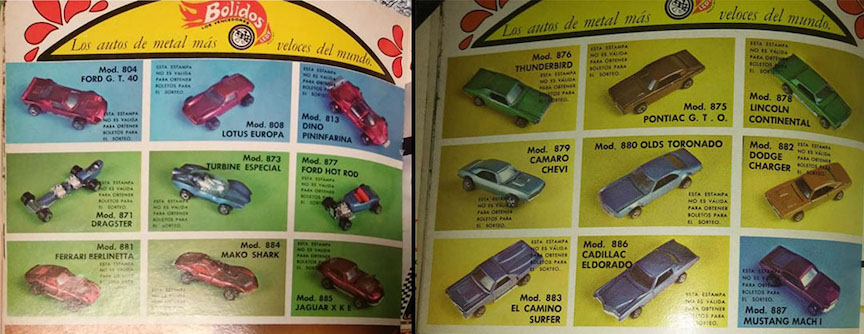
1972 Christmas Catalog
The 1972 Christmas catalog was an insert to the Reader's Digest "Selecciones" magazine. Attached using a glue strip, the catalog could
be removed intact. On two pages, it illustrates 18 different models, each with its own product number.
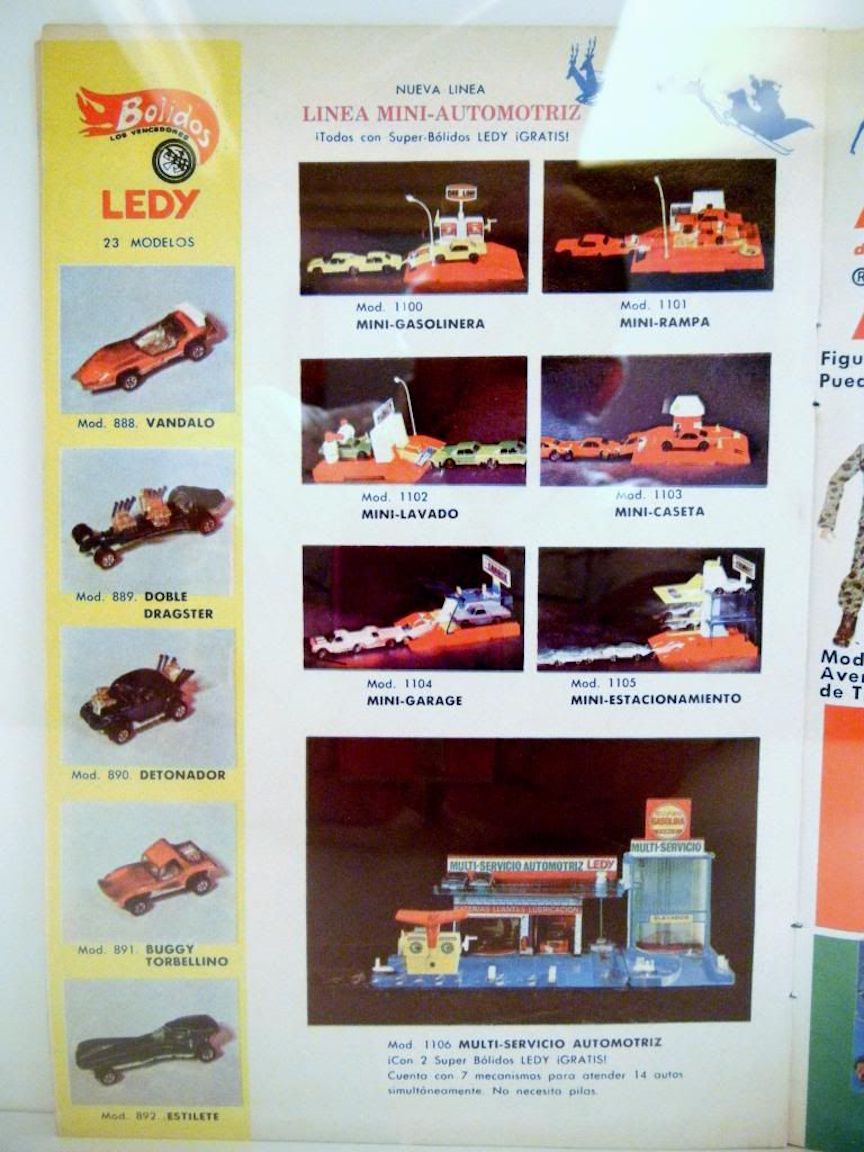
1973 Montgomery Ward Catalog Page
A page in the Mexican version of the 1973 Montgomery Ward Christmas Catalog shows 5 additional models each with its own product
number.
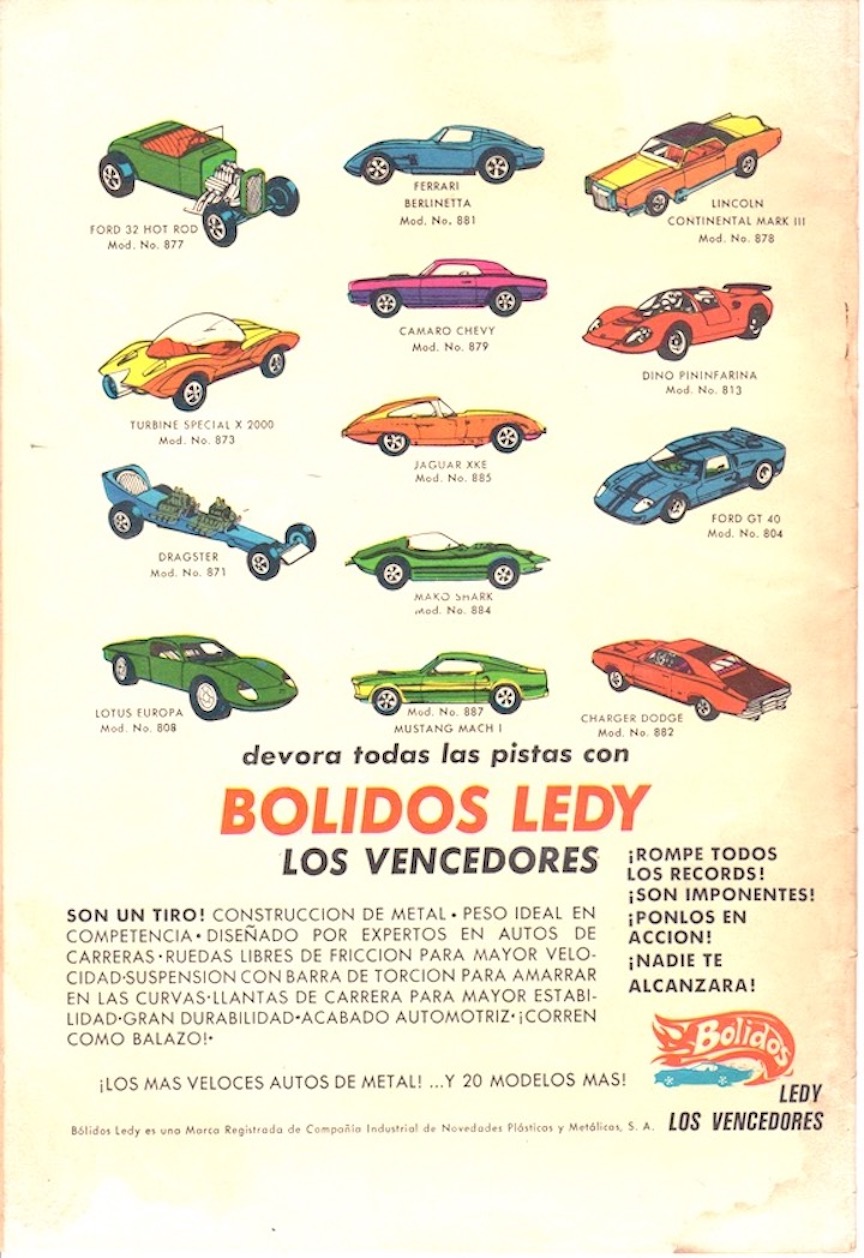
Comic Book Advertisement
This advertisement is on the back of a Tarzan Comic book. It illustrates 13 of the models seen in the 1972 Christmas catalog.
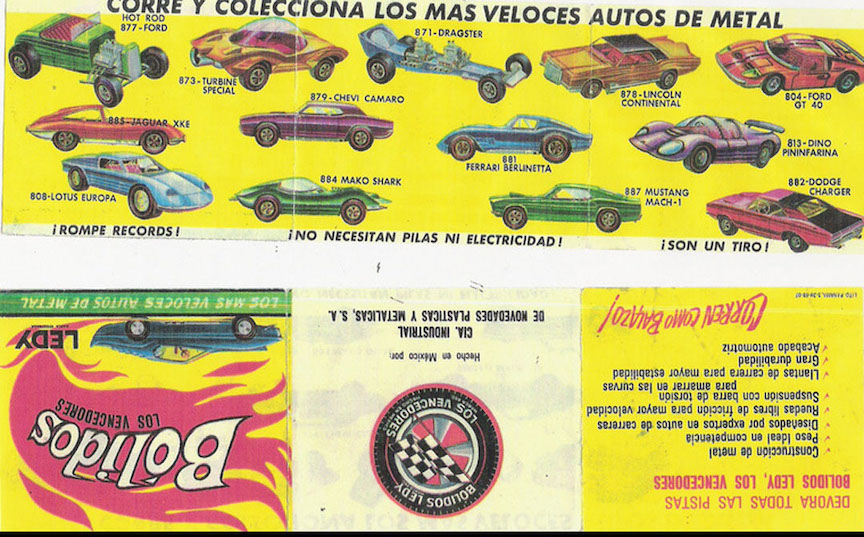
BP Insert
Each blister pack included a folded paper insert under the car. When unfolded, the insert reveals photos of 13 models seen in the
1972 Christmas catalog.
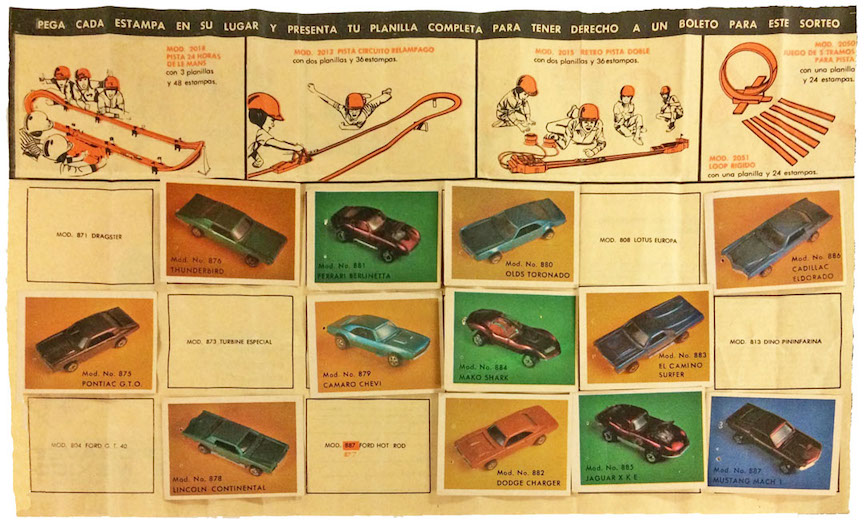
Bolidos Game Sheet
An example of a collecting game from 1971 or 1972 is known. The game required collecting small stamps of each car and some sort of
proof of purchase. The game sheet had spaces for all 18 of the models shown in the 1972 catalog.
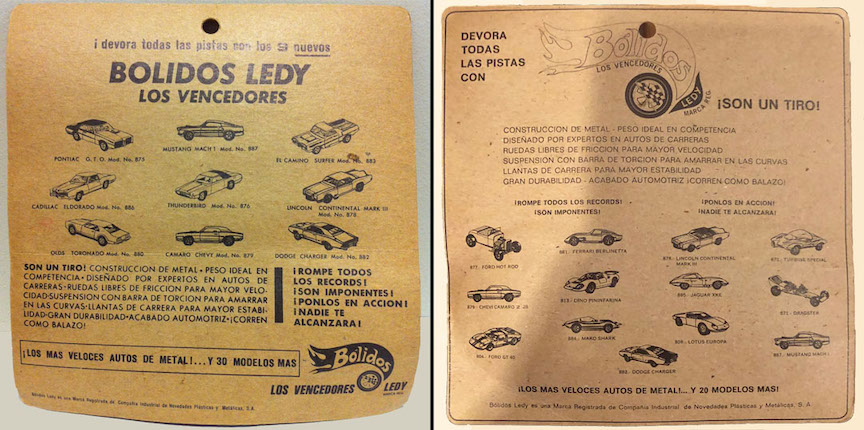
Two Different Blister Pack Cards
The card on the left illustrates 9 new (nuevo) models and states that there are 30 more (30 mas) indicating a total of 39 models.
The card on the right illustrates 13 models and states that there are 20 more models, indicating that a total of 33 models.
Between the two cards, all 18 of the models shown in the 1972 catalog are illustrated.
SUMMARY
In spite of the statements on the blister pack card, the evidence shows a total of 23 unique Bolidos models produced by LEDY.
Sixteen of the 23 models are found in Topper/Johnny Lightning's USA product line and all of them have the "Topper/Johnny Lightning"
logo on the base. LEDY assigned names that differ from the names assigned by Topper, however the name embossed on the base of the
car remains the original Topper name.
Seven of the 23 models are not known from the USA domestic Topper Johnny Lightning product line and three of the seven do not have
the "Topper Johnny Lightning" logo embossed on the base. It turns out that these three are models licensed from an Italian company,
Mercury Speedy Velox. Thus, they were never offered in the Topper/Johnny Lightning USA product line.
The remaining four models do have the "Topper Johnny Lightning" logo embossed on the base and are known as the "Lost Toppers".
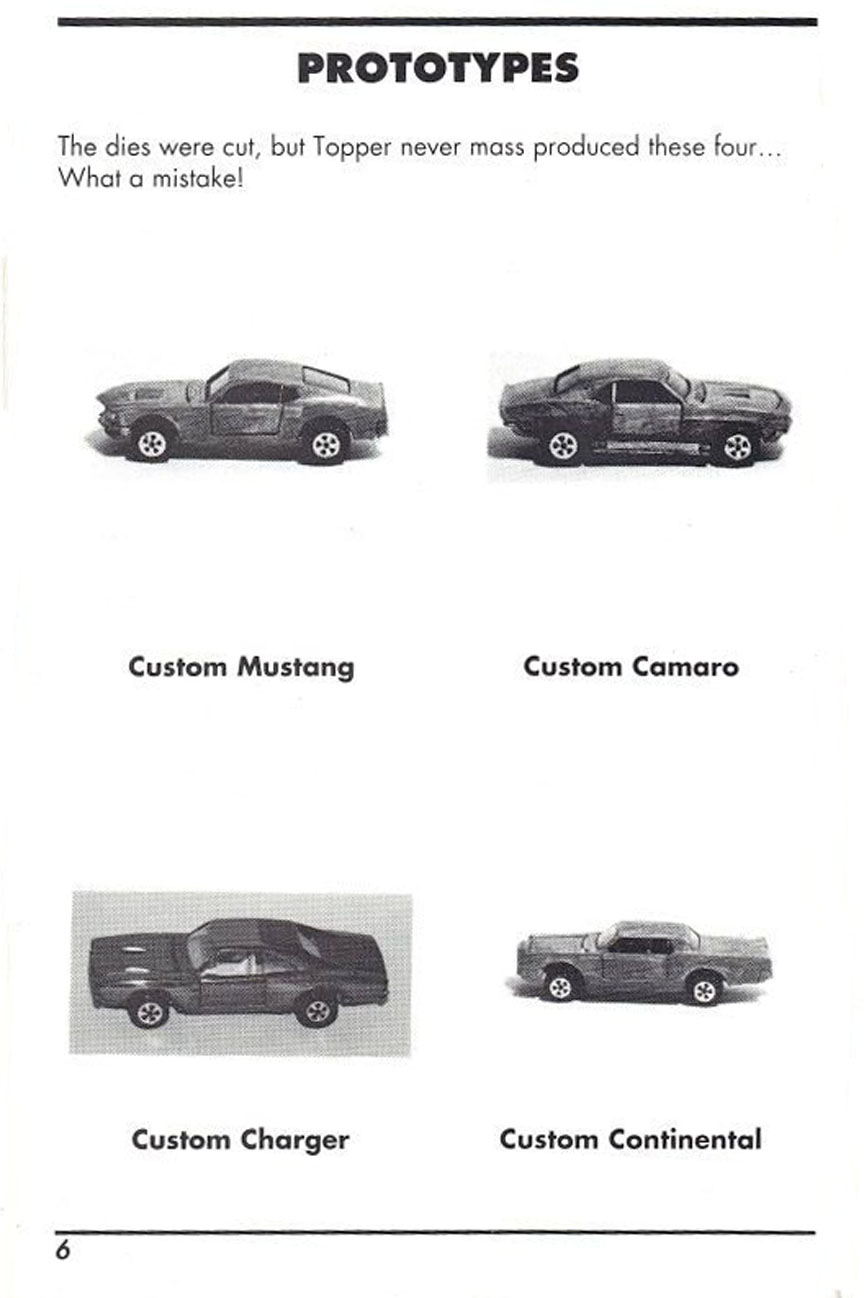
Page from Carter Pennington's "Collector's Guide to Topper Johnny Lightnings"
In 1993, Carter Pennington published a small 21 page booklet describing all of the Topper Johnny Lightning models made for the US
market. In his booklet, he describes four models which were obviously designed but never mass produced by Topper. All four are
replicas of American made cars, with the Mustang and Camaro being the two most iconic muscle cars. Although Pennington owned
several "preproduction" pieces, no mass production pieces were widely known in the US for over 30 years. The reasons behind the
decision to abandon the four models was lost to history, as were the cars, hence the term "the Lost Toppers".
Finding the "Lost Toppers"... The story as told by Shawn McClinic:
So it's sometime in 2004, at a major convention, and a bunch of the elite Topper guys are discussing (arguing!) the new wrinkle in the
world of vintage Johnny Lightning cars... an Eldorado and Thunderbird with black interiors, lousy paint and sealed doors WITH
doorlines show up at the convention as does a Lincoln Continental.
The Eldorado and T-Bird could be explained by saying someone reverse engineered them and that they were true knock offs/counterfeit.
But the Lincoln... well, it's one of the "Lost 4" as they are commonly called; the cars Topper intended to mass produce but due to
casting issues, trademark infringement and many other 'theories', they just weren't done. Those four are the Lincoln, Mustang, Camaro
and the Charger. And according to ALL of the topper gurus at the time, the only Lincoln known to be made by Topper was one complete
prototype and a very few test samples.
According to Carter and those elites at the time, there was no way anyone could have reversed the Lincoln. Carter owned the protos and
all of the test pieces that were known were accounted for as well, so where in the hell did it come from? Enter eBay! That's right, eBay.
A guy in Mexico City posts a Lincoln, black interior, ugly red paint and a bottom shot that looks like this...
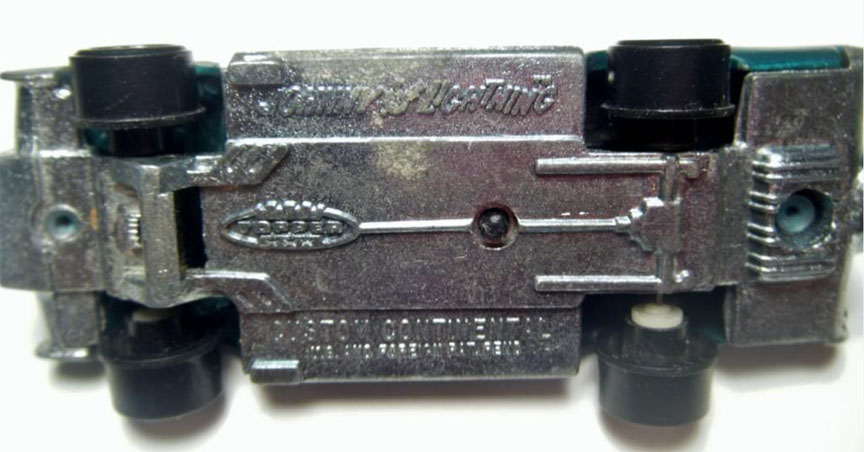
and... the Topper collecting world goes nuts!!! This isn't to say that this was the first time these cars were seen, but this was THE turning
point. We come to find out from this gentleman that a toy company by the name of Lili-Ledy had produced a line of die cast cars and
accessories from September 1971 until around May 1974. These little gems were called "BOLIDOS". They made 23 different models
and, this is the shocker... the "Lost 4" were included in those original castings.
So everything the Topper guys were spouting as gospel, that these cars were never mass produced, was wrong. So what else had they
gotten wrong? It sent the diecast community into a bit of a tailspin but it also gave the average collector....hope. Most of us could
never afford a one of a kind proto or test shot, but with Bolidos, we all have a chance to own a small piece of Topper history,
and alot less expensively. There is still a question that no one has been able to answer on this topic... who sold Ledy the molds and when?
We know the cars and sets appeared in the 1971-72 Ledy Christmas catalogue and did so for every year up to the spring catalogue of '74.
So did Henry Orenstein sell them before he was indicted for fraud in Nov 71? Had he made arrangements previously? No one knows.
And Henry won't speak on it, so we may never know.
Generalized Characteristics of Bolidos
Ledy Paints
Ledy paint colors differ significantly from Topper paint colors. The table below shows examples of recognizably distinct Ledy paint colors.
The names of the colors are subjective as everyone sees colors differently. More will be added as the colors are recognized.
 |
 |
 |
 |
| Blue |
Green |
Red |
Yellow |
 |
 |
 |
 |
| Brown |
Copper |
Gold |
Purple |
"Mirror" Finish
Topper made cars with a chrome finish under a translucent paint that are known as "Mirror" paints.

Bolido "Mirror" Finish Eldorado vs. Topper Custom Turbine Mirror Finish
Although still a point of contention among collectors, it appears that Ledy may have attempted to replicate the "mirror" finish.
The result is clearly inferior to the brilliant finish of a Topper Mirror piece.
Ledy Wheels

Topper 1st Year (L) vs. 2nd Year (C) vs. Bolido (R)
Topper changed the characteristics of their wheels from the first year to the second year of production.
Both wheels are representations of the five spoked "Mag Wheel" which was popular for customizing muscle cars at that time.
The first year wheels had red lines on the side walls and were embossed with the word "GOOD YEAR" on the tire.
The second year wheels omitted the red line and the text and were a small bit wider.
The wheels made by Ledy resemble the 2nd year Topper wheel but when compared closely, they are clearly different.
- The spokes of the "Mag Wheel" are narrower
- The hole in the center of the hub is larger
- In between the spokes, there is a ridge not seen on the Topper wheel
- The border between the tire and the hub is more distinct on the Ledy wheel
- The wheels made by Ledy were painted silver vs. chromed and the paint is quite fragile and is often completely worn away
Additionally, there is a characteristic which clearly separates the Bolidos wheels from the Topper wheels: the width of the tire.
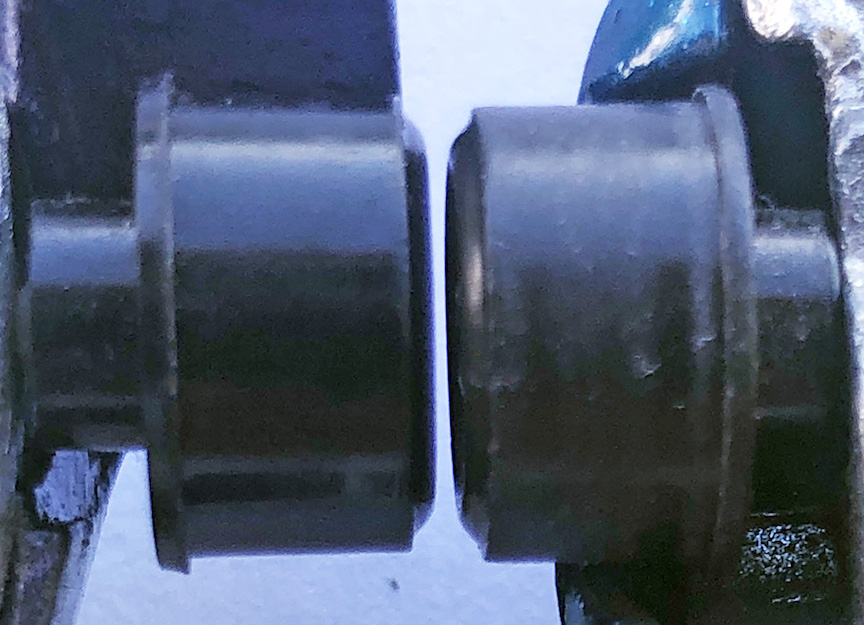
Topper 2nd Year (L) vs. Bolido (R)
Measured Width of the three types of wheels:
- Topper Goodyear - 5.66 mm
- Topper 2nd Year - 6.18 mm
- Ledy Bolidos - 6.32 mm
Although different in appearance and width, the three types of wheels are interchangeable.
Collectors should be aware that all Bolidos came with only the Ledy style wheels.

* DISCLAIMER *
Private use of original images is allowed.
Non-profit, non-commercial publication of original images is allowed only with prior expressed written consent from CIPSACars.com.
For other commercial, for-profit or redistribution needs, please contact the site owner. This site is not affiliated with Mattel, Inc.
Questions? ......Cars for sale?
Send an e-mail: tngray@nautiloid.net
© 2020 by TNGray. All Rights Reserved.





















